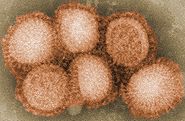Avian influenza: Difference between revisions
Kathrynbyers (talk | contribs) |
Kathrynbyers (talk | contribs) |
||
| Line 3: | Line 3: | ||
What kind of microbe is it (eg Cell morphology, shape, phylogenetic classification)? Is its genome sequenced, and if so, how big is the genome? | What kind of microbe is it (eg Cell morphology, shape, phylogenetic classification)? Is its genome sequenced, and if so, how big is the genome? | ||
==Characteristics of the host== | ==Characteristics of the host== | ||
Avian influenza affects | Avian influenza affects a variety of species. There are three types of this virus, type A, type B, and type C. Type A affects a range of animals including, but not limited to domesticated birds, such as chicken and turkey, wild birds, including ducks, gulls, and seabirds, mammals, such as horses, swine, and humans. Type B and C only affect humans. | ||
[[File:H1N1 navbox.jpg|thumb| Avian Influenza [http://en.wikipedia.org/wiki/File:H1N1_navbox.jpg CDC]]] | [[File:H1N1 navbox.jpg|thumb| Avian Influenza [http://en.wikipedia.org/wiki/File:H1N1_navbox.jpg CDC]]] | ||
Revision as of 18:43, 4 December 2011
Ex. [[]]
Characteristics of the symbiont/pathogen
What kind of microbe is it (eg Cell morphology, shape, phylogenetic classification)? Is its genome sequenced, and if so, how big is the genome?
Characteristics of the host
Avian influenza affects a variety of species. There are three types of this virus, type A, type B, and type C. Type A affects a range of animals including, but not limited to domesticated birds, such as chicken and turkey, wild birds, including ducks, gulls, and seabirds, mammals, such as horses, swine, and humans. Type B and C only affect humans.

Host-Symbiont Interaction
What kind of interaction do host and symbiont have? How is the host affected by the relationship? How does the host acquire and transmit the symbiont? Is the interaction obligate or facultative?
Molecular Insights into the Symbiosis
Describe molecular/genetic studies on the symbiosis.
Ecological and Evolutionary Aspects
What is the evolutionary history of the interaction? Do particular environmental factors play a role in regulating the symbiosis?
Recent Discoveries
Describe two findings on the symbiosis published within the last two years.
References
[1] Suarez, D. L., and Schultz-Cherry, S. 2000. Immunology of avian influenza virus: a review. "Developmental and Comparative Immunology." 24:269-283.
Edited by Nikki Byers, students of Grace Lim-Fong
